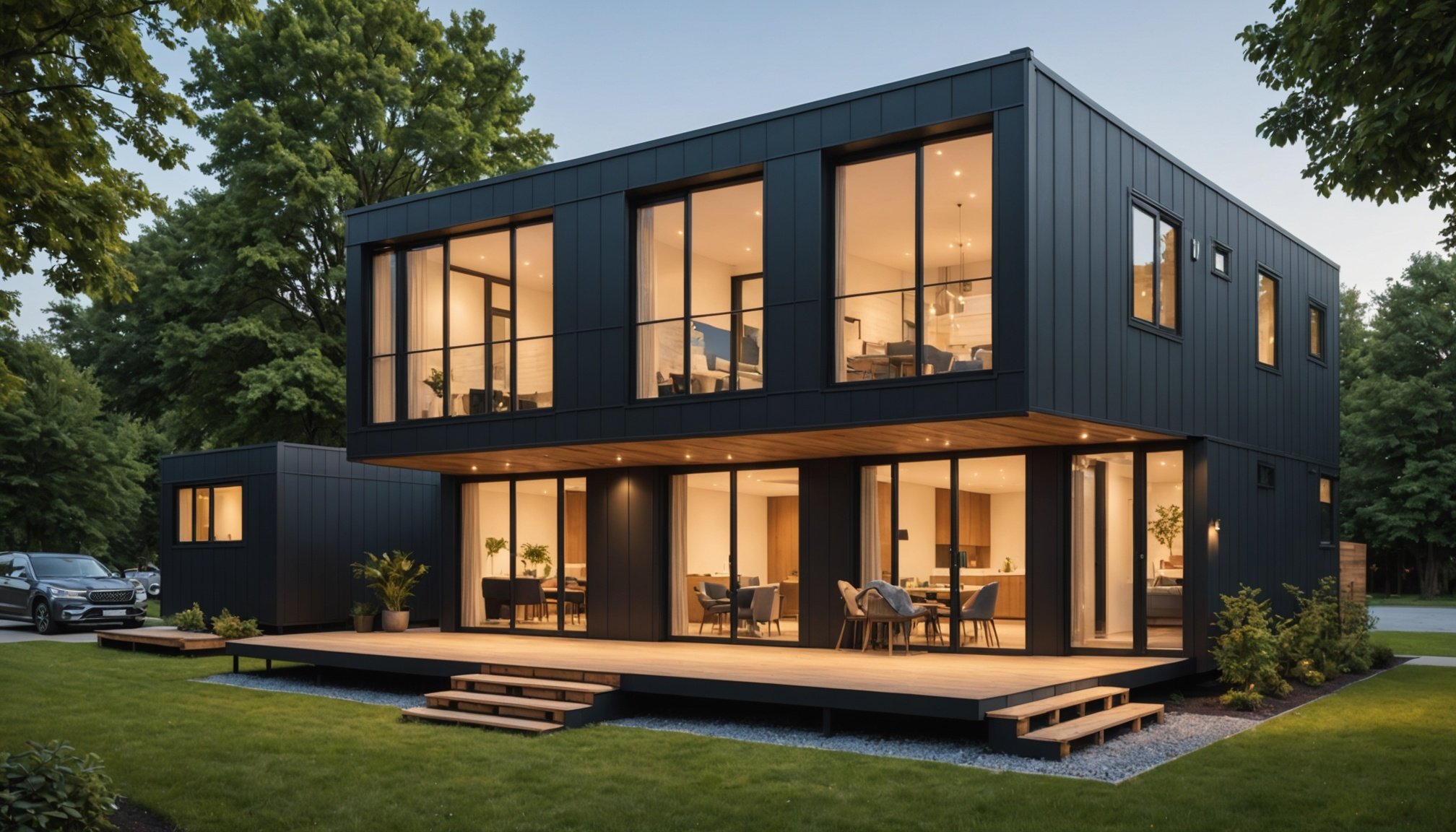Overview of Modular and Prefab Homes
Modular homes and prefab homes are increasingly gaining traction in urban housing trends. But what differentiates the two? In essence, modular homes are a type of prefab construction but with distinct characteristics. Modular homes are built in factory settings, usually in sections, which are then transported to and assembled on-site. This process ensures greater precision and uniformity in construction. On the other hand, prefab homes encompass a broader category, including manufactured homes and modular homes, where parts or modules are prebuilt and assembled elsewhere.
Historically, modular housing dates back to post-war periods, when rapid urban expansion required quick and efficient housing solutions. Since then, modular homes have evolved to reflect contemporary architectural designs and sustainable building practices. Currently, modular homes are riding the wave of urban housing trends, with a notable increase in market growth. This popularity surge is mirrored in urban landscapes, where modular housing solutions cater to the pressing demand for affordable and sustainable living spaces.
Overall, modular homes and prefab homes offer a practical, efficient, and environmentally friendly alternative to traditional home construction, marking a significant shift in urban development approaches.
Benefits of Modular and Prefab Homes
When considering the advantages of modular homes and benefits of prefab housing, it’s essential to highlight their fundamental cost-effectiveness compared to traditional construction methods. Building modular homes typically involves less labor and less material waste, leading to reduced overall expenses. This financial advantage makes them an attractive option for meeting urban housing demands, while also easing budget concerns for prospective homeowners.
Beyond cost savings, sustainability stands out as a significant benefit. Modular and prefab homes are designed to have a lower environmental footprint, incorporating eco-friendly materials and more efficient construction processes. The controlled factory settings allow for precise resource management, minimizing waste and promoting sustainable building practices.
Another major benefit is the speed of construction. Modular homes can be completed in dramatically less time since modules are built simultaneously with site preparation. This swift construction timeline addresses urgent housing needs in growing urban areas, providing quicker solutions to accommodate influxes of new residents.
Incorporating modular homes into urban environments not only meets immediate housing demands but does so in an economically and environmentally conscious manner. These dwellings present a progressive framework for sustainable and efficient housing solutions, positioning them as key players in evolving urban landscapes.
Challenges Facing Modular and Prefab Homes
Modular housing is not without its hurdles. One of the prominent challenges of prefab homes lies in navigating regulatory and zoning frameworks. Many regions have strict building codes which modular constructions must adhere to, often causing delays. In urban areas, these regulations can be particularly stringent, making it difficult to secure necessary approvals. This issue is compounded by the fact that modular housing was traditionally seen outside conventional building frameworks, requiring extensive negotiation to fit within existing structures.
Public perception also remains a challenge. While the industry is evolving, some still associate prefab homes with lower-quality builds, or view them as temporary solutions rather than permanent housing. Overcoming this stigma is essential for wider acceptance. Communicating the benefits and innovations in modern prefab construction can help shift these perceptions.
In terms of financing and insurance, modular housing can face limitations. Traditional financial institutions may be hesitant to finance modular projects due to unfamiliarity or perceived risks, leading to higher interest rates or more stringent loan requirements. Similarly, securing insurance for modular homes often involves overcoming barriers tied to market perceptions and historical data on these structures, which may not accurately reflect their current reliability and safety. Addressing these challenges will be crucial for future growth.
Urban Planning Implications of Modular and Prefab Homes
Incorporating modular homes into urban landscapes plays a crucial role in tackling housing shortages. As cities grapple with growing populations, traditional construction methods can no longer keep pace. Modular housing offers a swift and efficient alternative, crucial for meeting urban demands without compromising on quality or sustainability.
Sustainable urban development is closely linked with the increased adoption of modular homes. Their eco-friendly design, combined with efficient resource use, helps reduce the overall environmental footprint of housing projects. This aligns with the goals of smart city planning, which aims to create sustainable, liveable urban environments.
Successful integration of modular housing in urban settings requires collaboration between city planners and modular home developers. Effective partnerships can ensure that modular constructions complement existing infrastructure and meet regulatory standards. This cooperation fosters innovation in design and implementation, leading to housing solutions that are both functional and aesthetically pleasing.
Overall, the strategic use of modular and prefab homes within urban planning holds promise for addressing housing shortages in a sustainable manner. By aligning with smart city planning goals, modular homes are set to become a staple in the urban landscape, catering to growing populations while preserving environmental integrity.
Future Trends for Modular and Prefab Homes in Cities
The future of modular homes in urban settings is poised for growth, with emerging trends in housing reflecting shifting consumer preferences and technological advancements. Industry forecasts predict a significant rise in demand for prefab homes, driven by their adaptability, cost-efficiency, and environmental benefits. As urban populations continue to swell, prefabricated housing offers an attraction for individuals and governments looking to tackle housing crises, particularly in densely populated areas.
Technological advancements are set to revolutionise the modular housing sector. Innovations like advanced robotics and 3D printing enhance precision in manufacturing and enable quicker assembly, promising to make modular construction even more efficient and appealing. These developments not only streamline the building process but also allow for greater customisation, meeting the diverse needs of urban dwellers.
One trend gaining momentum is the integration of smart home technology into modular designs. As cities aim to become smarter, prefab homes equipped with energy-efficient systems and IoT devices can offer future residents a technologically sophisticated living experience, aligning with larger goals of creating smarter, more sustainable urban spaces. Collectively, these trends establish modular housing as a formidable player in addressing global housing challenges, today and into the future.
Design Innovations in Modular and Prefab Homes
In recent years, modern modular design and prefab home aesthetics have undergone remarkable transformations, making them an appealing choice for urban dwellers. These homes boast innovative design features and offer extensive customization options that resonate with varied consumer preferences. Homeowners today have the liberty to select from diverse layouts and styles, thus creating a unique living experience that aligns with personal tastes.
Cities around the world are embracing these design innovations, with numerous case studies highlighting successful implementations. For instance, projects in Berlin and Tokyo showcase modular housing developments integrating cutting-edge architectural trends and sustainable solutions.
Architectural trends in modular homes emphasize both functionality and visual appeal. The use of eco-friendly materials, coupled with smart technology integrations, make these homes not only aesthetically pleasing but also resource-efficient.
Consumer interest in modular housing is largely driven by a desire for customisable living spaces that reflect individual style and sustainability ethos. As these preferences shape the market, modular home manufacturers continue to adapt and offer designs that cater to this demand, ensuring that the homes remain relevant and attractive in evolving urban landscapes. Such developments signify a promising future for modular housing in metropolitan areas.










